Just a bit of history here. People had occupied this area from approx 550 A.D. and progressed from pit homes dug into the earth to homes built above ground to cliff dwellings built in the 1100 - 1300 A.D. These people were called Anasazi but are more correctly called the Ancient Puebloans. Here at Mesa Verde are 4800 known archeological sites, from fire rings to reservoirs to pit homes to intricate cliff dwellings. And, who knows how many other undiscovered sites?
It is, of course, the cliff drellings which are the most compelling. It was two cowboys searching for stray cattle in 1888 who first ‘discovered’ these. They could see a large structure through the swirling snow and climbed down a makeshift ladder to explore further. Imagine their amazement to find something like this carved into the sheer cliffs. These two then explored the entire area and found 180 cliff dwellings, though none as large as this one.
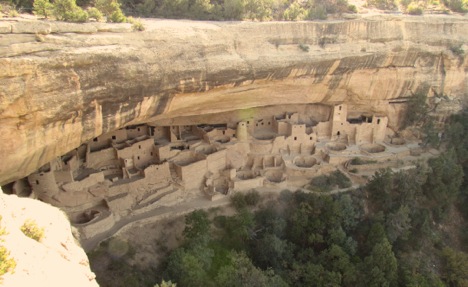
I know you’re asking me: Nancy, how did these huge alcoves form? Well, being the geologist that I am (not!) I can tell you that water seepage between the limestone and shale layers in the cliffs undermined a lot of rock which then sloughed (sloughed off is a geological term meaning ‘came crashing down’) off and left these huge alcoves. There, I’ve told you all I know about the geology. However, I might not know much about geology but I certainly can appreciate the impressive accomplishments of these people in developing their communities here. Truth to tell, they only lived in these cliff dwellings for aobut 75 years before they migrated south and left all they had built. Why they left is a mystery but their decendents, current Pueblo peoples, say that ‘they time had come’ to move on.
Their cliff dwellings are certainly impressive. The lower levels are rough stones whereas the highest layers are shaped smoothed blocks. Note in the photo below how rough the bottom of this structure is and how smooth the top is. Actually, most of the walls were painted but the paint has worn away. Their windows are square, their towers are straight plumbed, they built around what rocks there were in their alcoves and they built up to the top of the alcove. They fully used the space available. Cliff Palace, the largest, pictured above had 150 rooms and was home to approx. 150 people.
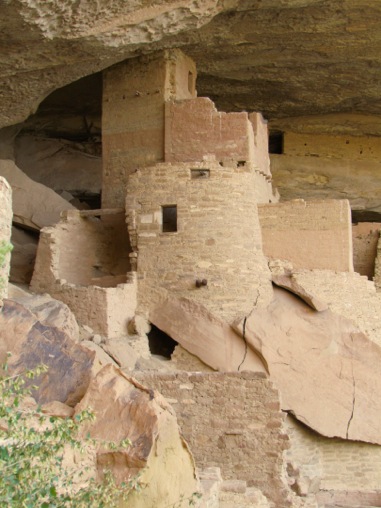
These people were amazing:
they built huge communities with buildings 4 stories tall inside cliff alcoves
they developed reservoirs and dams
they traded extensively and their pottery has been found in San Salvador and they were using potatoes from Peru
they developed the bow and arrow
they wove intricate baskets and made pottery
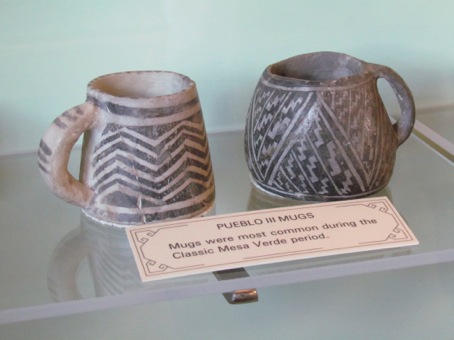
they developed terraced farming
they realized that the limestones on which they were grinding their corn were mixing tiny grains of limestone into the corn and were wearing down their teeth so they turned to harder river rocks for grinding
they could farm in a desert terrain using dry farming and feed themselves
they wove cotton into clothing
An impressive civilization.
We had tickets for a tour of Cliff Palace above and for Balcony House. Cliff Palace was impressive but we also enjoyed Blacony House. In this tour you:
walk down a 70’ staircase
climb up a 32’ ladder
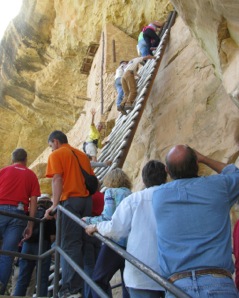
crawl through an 18” x 24” tunnel
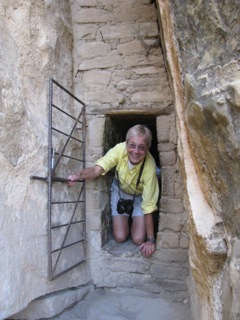
walk around a ledge with a sheer drop off
climb up a 38’ ladder

use toe holds carved into the stone and a railing to climb the final 30’.
DON’T LOOK DOWN!!!
You should have seen the kids in our tour scampering through all this. And, the original dwellers had none of these ladders and steps and railings. They had the toe and hand holds carved into the rocks.
Impressive tours and I developed an appreciation for living in a cliff house - luckily I got to use railings and ladders and not toe holds and hand holds.
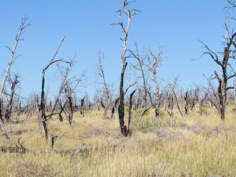
Another impressive feature of the park is the fires that have scarred it over the years. One fire, the Bircher fire in 2000 scorched 23,607 acres before it was stopped by 1106 firefighters working over 9 days. 300’ flames hampered this effort since they were too hot for retardants to work. The fire cost $5.5 million dollars and, because it was so close to tourist areas, closed the park for 2 week. The scars still remain and certain trees will take years to regrow. However, the fire revealed many more archeological sites that had not yet been discovered. All fires have been started by lightening not humans but the damage is the same.
We also toured another cliff dwelling and several of the individual homes built prior to the cliff homes.
We got back to town about 8:00 and succumbed to eating dinner in Denny’s.
We are worn out: we’ve been hiking, touring and moving from one location to another for 5 days and it’s time to rest. Tomorrow: laundry, vacuuming and general catch-up. We’re ready for a relaxing day.

It's hard to believe that it's been a year since we were at Mesa Verde. However, I wanted to comment on the runaway truck ramps--I can't tell from your picture, but most of them are gravel. An ex-truck driver said that most drivers try to AVOID them and hope the brakes come back because it's a pain to get towed out. I thought than would comfort you. One of my favorite signs was on I-5 just as you crossed into Oregon--Runaway trucks use rest stop. I guess the thinking was there was nothing like an RV to stop a runaway truck!
ReplyDeleteHi, Sherron,
ReplyDeleteI wrote a comment back to you on my iPad this morning but can't find it here this evening so will write it again.
I probably should have said more about the runaway truck ramps. Yes, they are usually very deep, soft sand so that trucks get stuck in them - this is what stops the runaway truck. Trucks then have to get a tow out of the sand which can be very expensive. This truck ramp looked like it was made of concrete - thus my comment that I wouldn't want to be at the bottom. Gary told me later that the concrete might just be a base for the sand.
On another topic - I can't get Sal and the 15 years out of my mind. Every time I look at my blog on line to check it, I see the comment about Sal and begin to hum the song. Thanks a lot, Sherron.